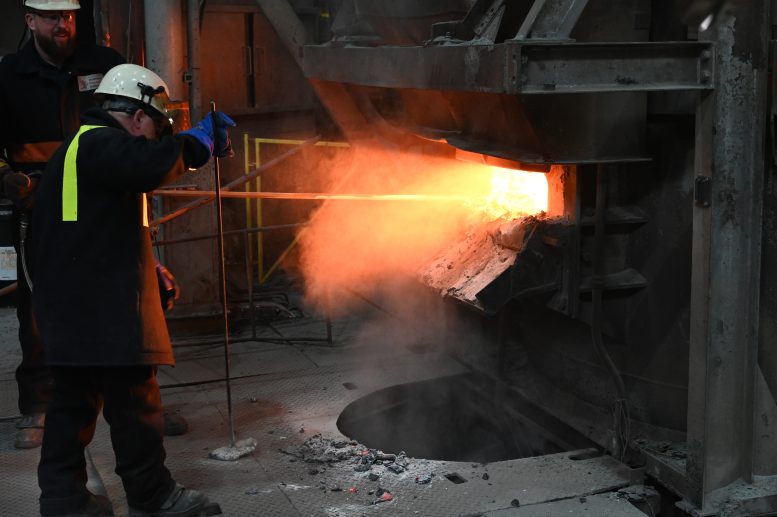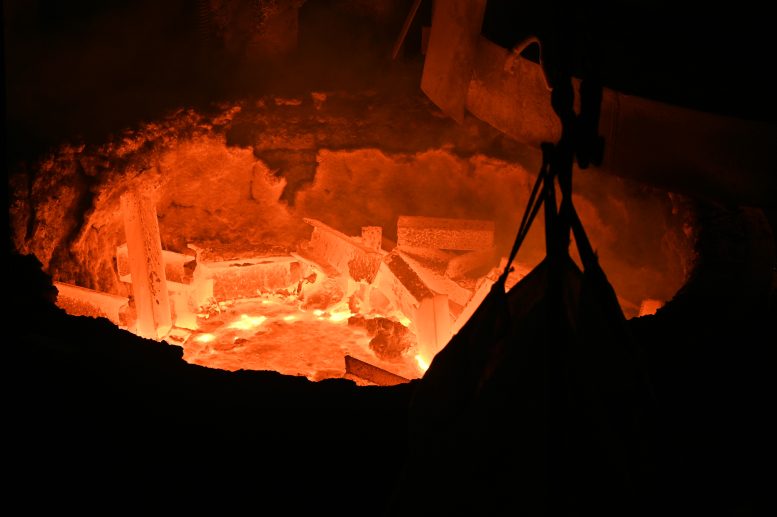
In a major stride toward sustainable construction, researchers at the University of Cambridge have developed a revolutionary method to produce low-emission concrete using electric arc furnaces. This method not only recycles cement but also promises significant reductions in CO2 emissions. If adopted widely and powered by renewable energy, it could lead to zero-emission cement production.
Cambridge researchers have developed a groundbreaking method to produce low-emission concrete, potentially revolutionizing the construction industry and aiding global efforts to achieve net-zero emissions.
Researchers at the University of Cambridge have created a method for producing low-emission concrete on a large scale, a breakthrough that could significantly impact the shift towards net zero emissions. This method, described by the researchers as “an absolute miracle,” leverages electric arc furnaces—commonly used in steel recycling—to also recycle cement, a major carbon-intensive element of concrete.
Concrete is the second-most-used material on the planet, after water, and is responsible for approximately 7.5% of total anthropogenic CO₂ emissions. A scalable, cost-effective way of reducing concrete emissions while meeting global demand is one of the world’s biggest decarbonization challenges.
The Cambridge researchers found that used cement is an effective substitute for lime flux, which is used in steel recycling to remove impurities and normally ends up as a waste product known as slag. But by replacing lime with used cement, the end product is recycled cement that can be used to make new concrete.
The cement recycling method developed by the Cambridge researchers, reported in the journal Nature, does not add any significant costs to concrete or steel production, yet it significantly reduces emissions from both concrete and steel, due to the reduced need for lime flux.
Testing and Potential for Zero Emission
Recent tests carried out by the Materials Processing Institute, a partner in the project, showed that recycled cement can be produced at scale in an electric arc furnace (EAF), the first time this has been achieved. Eventually, this method could produce zero-emission cement, if the EAF was powered by renewable energy.
“We held a series of workshops with members of the construction industry on how we could reduce emissions from the sector,” said Professor Julian Allwood from Cambridge’s Department of Engineering, who led the research. “Lots of great ideas came out of those discussions, but one thing they couldn’t or wouldn’t consider was a world without cement.”

Photographs of the first electric cement production in an electric arc furnace at the Materials Processing Institute, UK. Credit: Materials Processing Institute
Concrete is made from sand, gravel, water, and cement, which serves as a binder. Although it’s a small proportion of concrete, cement is responsible for almost 90% of concrete emissions. Cement is made through a process called clinkering, where limestone and other raw materials are crushed and heated to about 1,450°C in large kilns. This process converts the materials into cement, but releases large amounts of CO₂ as limestone decarbonates into lime.
Challenges With Alternative Materials
Over the past decade, scientists have been investigating substitutes for cement, and have found that roughly half of the cement in concrete can be replaced with alternative materials, such as fly ash, but these alternatives need to be chemically activated by the remaining cement in order to harden.
“It’s also a question of volume – we don’t physically have enough of these alternatives to keep up with global cement demand, which is roughly four billion tonnes per year,” said Allwood. “We’ve already identified the low-hanging fruit that helps us use less cement by careful mixing and blending, but to get all the way to zero emissions, we need to start thinking outside the box.”
“I had a vague idea from previous work that if it were possible to crush old concrete, taking out the sand and stones, heating the cement would remove the water, and then it would form clinker again,” said first author Dr. Cyrille Dunant, also from the Department of Engineering. “A bath of liquid metal would help this chemical reaction along, and an electric arc furnace, used to recycle steel, felt like a strong possibility. We had to try.”

Photographs of the first electric cement production in an electric arc furnace at the Materials Processing Institute, UK. Credit: Materials Processing Institute
The clinkering process requires heat and the right combination of oxides, all of which are in used cement, but need to be reactivated. The researchers tested a range of slags, made from demolition waste and added lime, alumina, and silica. The slags were processed in the Materials Processing Institute’s EAF with molten steel and rapidly cooled.
“We found the combination of cement clinker and iron oxide is an excellent steelmaking slag because it foams and it flows well,” said Dunant. “And if you get the balance right and cool the slag quickly enough, you end up with reactivated cement, without adding any cost to the steelmaking process.”
The cement made through this recycling process contains higher levels of iron oxide than conventional cement, but the researchers say this has little effect on performance.
The Cambridge Electric Cement process has been scaling rapidly, and the researchers say they could be producing one billion tonnes per year by 2050, which represents roughly a quarter of current annual cement production.
“Producing zero emissions cement is an absolute miracle, but we’ve also got to reduce the amount of cement and concrete we use,” said Allwood. “Concrete is cheap, strong, and can be made almost anywhere, but we just use far too much of it. We could dramatically reduce the amount of concrete we use without any reduction in safety, but there needs to be political will to make that happen.
“As well as being a breakthrough for the construction industry, we hope that Cambridge Electric Cement will also be a flag to help the government recognize that the opportunities for innovation on our journey to zero emissions extend far beyond the energy sector.”
Reference: “Electric recycling of Portland cement at scale” by Cyrille F. Dunant, Shiju Joseph, Rohit Prajapati and Julian M. Allwood, 22 May 2024, Nature.
DOI: 10.1038/s41586-024-07338-8
The researchers have filed a patent on the process to support its commercialization. The research was supported in part by Innovate UK and the Engineering and Physical Sciences Research Council (EPSRC), part of UK Research and Innovation (UKRI).









Something that wasn’t said, but needs to be, is that electric arc furnaces for making steel need to have a reliable source of electricity. The electricity needs to consistent until the batch is ready to be poured. Thus, most ‘renewable’ sources of electricity, i.e. solar and wind are problematic. Solar is most reliable in the middle of the day, but is subject to downturns and even outages from clouds, hail damage, and the inevitable daily setting of the sun. Similarly, wind power is highly variable and intermittent. If the power goes down before the batch of steel is ready to pour, one is at risk of having a multi-ton slug of steel locked in the walls of fire brick, necessitating disassembling the furnace, and cutting up the huge block of solid steel into sizes that can be used to re-charge a new furnace built on the original site. Such setbacks would not only be expensive, but might negate the CO2 reductions.
Added to this basic concern is that there is little thought being given to the sources of copper needed for this all-electric power transition and it is probable that the transition will be characterized by a grid that is more unstable than today, and increased costs for power that will be passed on to all consumers. That is, even more inflation than what we have been witnessing recently. As I have remarked before, just because something is technologically possible, doesn’t mean that it will be economically possible, or be adopted even if it is.
Off course it’s “grpundbreaking”. Ground is what you break when you need ingredients for cement.
But seriously – what are the guarantees this new cement will be durable? How are they treating us for longevity?
Why do I even bother asking? If these people were serious they wouldn’t be so up in arms against CO2. It’s not the culprit.
I hate autocorrect.
This is a wonderful breakthrough! Even if not yet powered by renewables.